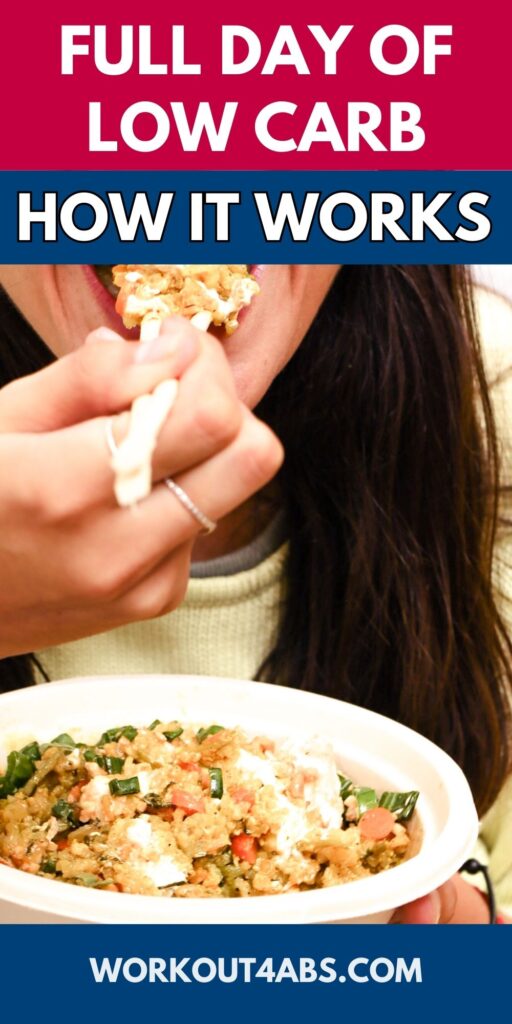Discover the power of a low carb diet meal plan. Embarking on a journey towards weight loss with this comprehensive guide presents a month-long roadmap, blending flavorful choices, balanced nutrition, and portion control to help you shed pounds effectively and sustainably.
3-Day EATING PLAN to Start or Restart Low Carb Dieting
If you enjoyed these tips, please save this pin to your Pinterest Board.

Low Carb Diet Meal Plan
Here’s a sample month-long low-carb diet meal plan for weight loss. Remember to adjust portion sizes based on your individual needs and consult a healthcare professional before making significant dietary changes.
Week 1:
Day 1:
- Breakfast: Scrambled eggs with spinach and tomatoes.
- Lunch: Grilled chicken salad with mixed greens, cucumber, bell peppers, and olive oil vinaigrette.
- Dinner: Baked salmon with steamed broccoli and cauliflower rice.
Day 2:
- Breakfast: Greek yogurt with berries and a sprinkle of chopped nuts.
- Lunch: Turkey lettuce wraps with avocado, bell peppers, and salsa.
- Dinner: Grilled steak with sautéed zucchini and a side salad.
Day 3:
- Breakfast: Omelette with mushrooms, onions, and feta cheese.
- Lunch: Tuna salad with mixed greens, olives, and lemon vinaigrette.
- Dinner: Baked chicken thighs with roasted Brussels sprouts and asparagus.
Day 4:
- Breakfast: Cottage cheese with sliced peaches and a drizzle of honey.
- Lunch: Zucchini noodles with pesto and grilled shrimp.
- Dinner: Stir-fried tofu with bell peppers, snap peas, and a ginger-soy sauce.
Week 2:
Day 1:
- Breakfast: Chia seed pudding with almond milk, topped with raspberries.
- Lunch: Spinach and feta stuffed chicken breast with a side of green beans.
- Dinner: Grilled fish with sautéed spinach and a side salad.
Day 2:
- Breakfast: Scrambled eggs with diced tomatoes, onions, and a sprinkle of cheese.
- Lunch: Greek salad with grilled chicken, olives, feta cheese, and balsamic vinaigrette.
- Dinner: Cauliflower crust pizza topped with veggies and lean turkey sausage.
Day 3:
- Breakfast: Smoothie with almond milk, spinach, berries, and a scoop of protein powder.
- Lunch: Cucumber and avocado salad with smoked salmon.
- Dinner: Beef stir-fry with broccoli, bell peppers, and a sesame-ginger sauce.
Day 4:
- Breakfast: Ricotta cheese with sliced strawberries and a drizzle of vanilla extract.
- Lunch: Chicken and vegetable skewers with a side of mixed greens.
- Dinner: Stuffed bell peppers with ground turkey, cauliflower rice, and diced tomatoes.
Week 3 and 4:
Continue rotating meals from Weeks 1 and 2, making sure to maintain variety and include different protein sources, vegetables, and healthy fats.
General Guidelines:
- Snacks: Choose from options like sliced veggies with hummus, a handful of nuts, or a small piece of cheese.
- Hydration: Drink plenty of water, herbal teas, and infusions throughout the day.
- Avoid processed foods, sugary beverages, and excessive high-carb foods.
- Listen to your body’s hunger and fullness cues.
Remember that a low-carb diet should be balanced and nutrient-dense. It’s important to consume adequate protein, healthy fats, and a variety of vegetables to ensure you’re meeting your nutritional needs. Individual preferences and dietary restrictions can also impact food choices. Consulting a registered dietitian or nutritionist for personalized guidance is recommended before starting any new diet plan.
If you enjoyed these tips, please save this pin to your Pinterest Board.

The Carbohydrates You Need to Lose Weight
The difference between carbohydrates that spike your blood sugar and those that don’t lies in their glycemic index (GI) and fiber content. Carbohydrates are classified based on how quickly they raise blood sugar levels after consumption. Here’s how it works and how carbohydrates from plants can aid weight loss:
- Glycemic Index (GI): The glycemic index is a ranking system that categorizes carbohydrates based on their impact on blood sugar levels. Carbohydrates with a high GI are rapidly digested and cause a quick spike in blood sugar levels, followed by a rapid drop, which can lead to cravings and hunger. Carbohydrates with a low GI are digested more slowly, leading to a gradual and sustained increase in blood sugar levels.
- Fiber Content: Fiber is a component of plant-based carbohydrates that has a significant impact on blood sugar levels. High-fiber foods slow down the digestion and absorption of carbohydrates, leading to a more controlled and gradual increase in blood sugar levels.
Carbohydrates from plants can indeed help with weight loss due to their characteristics:
- Filling and Satiety: Plant-based carbohydrates, particularly those high in fiber like whole grains, vegetables, legumes, and fruits, tend to be more filling. They provide a sense of satiety, reducing the likelihood of overeating and snacking between meals.
- Stable Blood Sugar Levels: Carbohydrates from plants with low GI and high fiber content cause a slower and steadier increase in blood sugar. This prevents the rapid spikes and crashes associated with high-GI foods, helping to control appetite and reduce cravings.
- Nutrient Density: Plant-based carbohydrates are often rich in essential vitamins, minerals, antioxidants, and other beneficial compounds. These nutrients contribute to overall health while also supporting weight loss by providing your body with the necessary tools for proper functioning.
- Lower Calorie Density: Many plant-based carbohydrates are lower in calories compared to processed and high-sugar options. This allows you to consume larger portions while staying within a calorie deficit, a key factor in weight loss.
- Enhanced Digestion: The fiber in plant-based carbohydrates supports digestive health and can prevent constipation, bloating, and other discomforts that might hinder weight loss efforts.
Examples of carbohydrates from plants that can support weight loss include quinoa, oats, sweet potatoes, leafy greens, berries, and legumes. It’s important to note that while plant-based carbohydrates can aid weight loss, balance and moderation are crucial. Combining a variety of nutrient-dense foods, including healthy fats and lean proteins, in your diet will provide a well-rounded approach to achieving and maintaining a healthy weight.
Low Glycemic Index Foods
Here are some examples of foods that have a low GI:
- Non-Starchy Vegetables: Vegetables such as broccoli, spinach, kale, cauliflower, and bell peppers have very low GI values due to their high fiber content and minimal carbohydrate content.
- Legumes: Beans, lentils, chickpeas, and other legumes are rich in fiber and protein, leading to a slower digestion process and lower blood sugar response.
- Whole Grains: Whole grains like quinoa, brown rice, barley, and whole wheat pasta have a lower GI compared to refined grains. They contain more fiber and nutrients, which slow down digestion.
- Fruits: While some fruits have a moderate GI due to their natural sugar content, certain options like berries (strawberries, blueberries, raspberries), apples, pears, and oranges have lower GI values due to their fiber content.
- Nuts and Seeds: Nuts and seeds, such as almonds, walnuts, chia seeds, and flaxseeds, have healthy fats, fiber, and protein that contribute to a lower GI response.
- Dairy: Dairy products like plain yogurt, milk, and kefir (especially those with no added sugars) have relatively low GI values due to their protein and fat content.
- Sweet Potatoes: While they are a carbohydrate source, sweet potatoes have a lower GI compared to regular white potatoes, likely due to their fiber and complex carbohydrate content.
- Steel-Cut Oats: These minimally processed oats have a lower GI compared to instant or quick oats, as they contain more fiber and take longer to digest.
- Bulgar: A whole grain with a low GI that’s often used in salads and Middle Eastern dishes.
- Non-Caloric Sweeteners: Some artificial sweeteners like stevia, erythritol, and xylitol have a negligible impact on blood sugar levels and are considered low GI options.
It’s important to note that the GI of a food can be influenced by factors such as ripeness, cooking methods, and how the food is prepared. Combining low-GI foods with protein, healthy fats, and fiber can further help stabilize blood sugar levels and support overall health. Remember that while the GI is a useful tool, it’s just one aspect of a healthy diet. Prioritizing a balanced and varied diet with a focus on whole, nutrient-dense foods is key to optimal health and well-being.
If you enjoyed these tips, please save this pin to your Pinterest Board.

Home › How Long is Intermittent Fasting ›Low Carb Diet Meal Plan